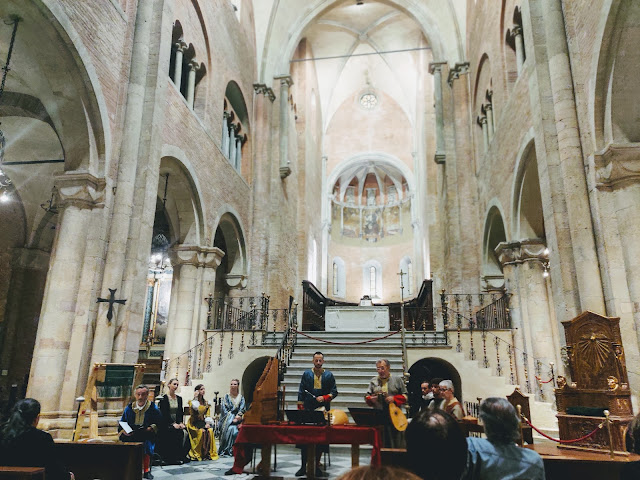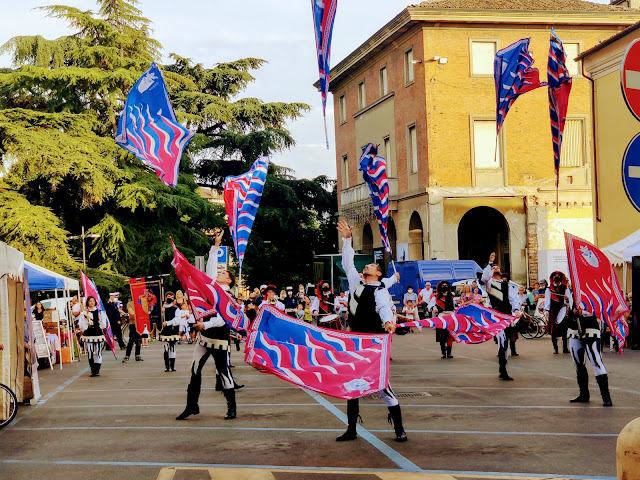In medieval times the Via Francigena was Christians' primary way to get from England and France to Rome and beyond. A statue of the apostle Simon Peter on the facade of Fidenza's Duomo points south and holds a scroll reading, "I show you the way to Rome." It's often described as the world's first road sign.
 |
| They went thataway. |
Later the Italian road faded in importance and today it is much less well known than Spain's Cammino de Santiago. But both were part of a harsh spiritual discipline. Devotees were required to travel vast distances on foot and endure bad weather, disease, discomfort, and worse in order to affirm their faith, do penance, or petition for a cure.
In recent years international tourists' interest in a slightly less strenuous version of playing pilgrim has not gone unnoticed. Offering a mix of exercise, spirituality, and pedestrian adventure, these walks--now with better shoes and Airbnbs, at least in some parts of the journey--are becoming increasingly popular. And so Italy and towns along the Via Francigena have begun publicizing its history and improving its accessibility.
Fidenza has a lot of civic spirit, and it was already proud to be a stop on the Francigena. So it's no surprise that the town fathers have now decided to make an even bigger deal of celebrating the ancient road. Held this year for the first time, the Francigena Festival Fidenza is a big new addition to the town's busy calendar of festas, conferences, and other events.
The festival included a lot of high-level discussions of history, architecture, food, and travel, featuring such luminaries as journalist and TV personality Beppe Severgnini and architect Mario Botta, plus a series of concerts and other performances. Jet-lagged as I was, I didn't attempt any of the talks. But one evening we did go to a lovely concert of medieval music, much of it pilgrimage-related, in the Duomo.
 |
| Singers were accompanied by a harmonium, a lute, a hurdy-gurdy, and scallop-shell castanets. |
The next day, the piazza in front of the town theater was the stage for a troupe of professional flag-wavers, exponents of "the noble art of bandiera." Sporting medieval costumes and accompanied by drums and brass played by the town band, the sbandieratori put on an eye-popping display of color and coordination as their brightly colored flags flared in kaleidoscopic patterns and flew into the air. Even in an age of computerized special effects, this was pretty spectacular to watch.
 |
| Town notables were on hand, including an officer of the carabinieri (I think). |
 |
| Like juggling, but with flags. |
The weekend also included several walks along local bits of the Via Francigena. One afternoon outing was canceled because of the threat of rain, but the next evening a night-time walk went on as planned, despite a chance of storms. Our neighbor Pia and I joined the moonlit walk, which went into a regional park just outside of town, a park whose entrance, hidden at the end of a little side street, had previously eluded all my attempts to locate it.
We were given tiny flashlights to help us avoid tripping over roots and rocks. In the distance we could hear dogs barking and what sounded like the howls of wolves--and there are wolves in the wooded areas around Fidenza. Occasional flashes of distant (we hoped) lightning lit up the sky. It was beautiful out there in the dark but also rather ominous.
 |
| Pausing en route for some music. |
The guide leading the walk talked about what it must have been like to travel the long pilgrimage route by yourself in the days when most of the countryside was as unpopulated as this park, and asked us to imagine the kind of spiritual reckoning that feelings of smallness and aloneness might provoke. We were hardly alone, though. There were about 35 of us, including several visitors from other parts of Italy and one each from the United Kingdom and France, as well as a local singer-songwriter who entertained us along the way with some traditional and original songs. We were modern pilgrims, pursuing the new grail of experiences.
Horrifying but also tedious as the event dragged on, despite the efforts of two loud-mouth announcers to inject excitement into the process. Well before a winner was announced, Danny and I gave up our seats and went on our own brief pilgrimage in search of refreshment. We settled into a bar near the Duomo and had some prosecco and a plateful of ham. All we had to do for it was present a credit card.
Having often heard the expression "climbing the greasy pole" used to describe the struggle to succeed in politics and business, I was excited to see that the festival program included the source of this metaphor: a "palo della cuccagna," a Cockaigne pole, in one of the smaller piazzas.
The name refers to the mythical Land of Cockaigne, where roast geese fly into your mouth and wine flows in the streams, a medieval European version of our Big Rock Candy Mountain. The game challenges contestants to climb a tall pole slathered in grease--lard in this case, I believe--and be the first to reach the prize at the top. The prize is usually a ham, and in this part of the world that means several prosciutti di Parma.
 |
| At the top of the pole. |
That day four teams competed for the prizes. These weren't random folks but men (mostly, plus one 12-year-old girl) in matching coveralls. They took turns trying to get up the pole, flinging as much lard off the pole as they could during the 30 or 45 seconds they were allotted in each round. In between attempts the players rubbed sand on their increasingly greasy coveralls, to make themselves a little less slippery.
Little by little the teams crept higher on the pole by climbing onto the shoulders of the person above them. There was a net, but still it was a little horrifying to see people scrambling over each other to get at a ham, particularly since these hams were probably plastic.
Horrifying but also tedious as the event dragged on, despite the efforts of two loud-mouth announcers to inject excitement into the process. Well before a winner was announced, Danny and I gave up our seats and went on our own brief pilgrimage in search of refreshment. We settled into a bar near the Duomo and had some prosecco and a plateful of ham. All we had to do for it was present a credit card.






3 comments:
It is all so rich! and full of color. A treat to nourish faith that this sere droughty time will someday give itself up to some sweet rainy wetness. Thank you! 🧡🙏 ❤️
Sounds like you are having a wonderful time! I enjoyed just reading this wonderfully well-written post about it. Thanks so much for sharing these experiences with us!
They have an annual Fiesta in the Portuguese-Italian port city of Gloucester, MA at which men (no 12-year old girls)slide along a greasy pole extended out across the harbor. They do not reach for a ham, but a flag, and I don't know that they win anything more than their photo on the city paper the next day. It sounds that it is more exciting than your show, since we onlookers get perverse thrill in watching the guys fall into the ocean as they reach for glory.
P.s. I love your translation of the first street sign. "They went thataway."
Post a Comment